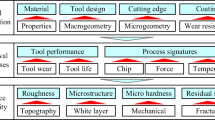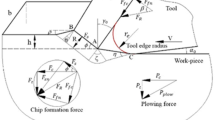Abstract
Edge preparation has gained widespread use due to its low cost and high impact. Various edge preparation methods are reported in the literature. Choice of edge preparation techniques influences the edge properties and the ensuing tool performance. The current work investigates the influence of three different edge preparation methods, brushing, drag finishing, and wet abrasive jet machining on the performance of tungsten carbide inserts during orthogonal turning. Edge preparation not only changes the geometry but also the properties of the edge. Experimental results show that a drag finished edge has the lowest edge surface roughness (Ra = 0.42 μm), while abrasive jet machining can induce 63% greater compressive residual stress than the unprepared tool. Reduction in tool wear was observed at the same stage of cutting length in the prepared edges alongside improved edge hardness. A thermomechanical finite element analysis is performed to evaluate the thermomechanical behavior of all the cutting edges. Results demonstrate that the use of prepared cutting edges enhances stress distribution and reduces the temperature. Experimental results confirm that the drag finished edge has the best overall performance out of the three edge techniques with lower cutting temperature, better stress distribution, lower cutting forces, reduced flank wear, and reduced roughness of the machined surface finish.



















Similar content being viewed by others
References
Rodríguez C (2009) Cutting edge preparation of precision cutting tools by applying micro-abrasive jet machining and brushing. Kassel university press GmbH, Kassel
Byrne G, Dornfeld D, Denkena B (2003) Advancing cutting technology. CIRP Ann Manuf Technol 52(2):483–507
Denkena B, Biermann D (2014) Cutting edge geometries. CIRP Ann Manuf Technol 63(2):631–653
Denkena B, Köhler J, Ventura CEH (2013) Customized cutting edge preparation by means of grinding. Precis Eng 37(3):590–598
Denkena B, Köhler J, Breidenstein B, Abrão AM, Ventura CEH (2014) Influence of the cutting edge preparation method on characteristics and performance of PVD coated carbide inserts in hard turning. Surf Coat Technol 254:447–454
Wyen C-F (2011) Rounded cutting edges and their influence in machining titanium. ETH, Zürich
Biermann D, Aßmuth R, Schumann S, Rieger M, Kuhlenkötter B (2016) Wet abrasive jet machining to prepare and design the cutting edge micro shape. Procedia CIRP 45:195–198
Wyen C-F, Wegener K (2010) Influence of cutting edge radius on cutting forces in machining titanium. CIRP Ann Manuf Technol 59(1):93–96
Krebs E, Wolf M, Biermann D, Tillmann W, Stangier D (2018) High-quality cutting edge preparation of micromilling tools using wet abrasive jet machining process. Prod Eng 12(1):45–51
Bouzakis KD, Michailidis N, Skordaris G, Kombogiannis S, Hadjiyiannis S, Efstathiou K, Erkens G, Rambadt S, Wirth I (2002) Effect of the cutting edge radius and its manufacturing procedure, on the milling performance of PVD coated cemented carbide inserts. CIRP Ann Manuf Technol 51(1):61–64
Denkena B, Bassett E, Köhler J (2012) On the honed cutting edge and its side effects during orthogonal turning operations of AISI1045 with coated WC-Co inserts. CIRP J Manuf Sci Technol 5:108–126
Wang H, Yu A, Dong L, Wu L (2011) Edge preparation of carbide tools with abrasive brushing method. 2011 2nd Int. Conf. Mech. Autom. Control Eng. MACE 2011 - Proc., pp 256–259
Fulemova J, Janda Z (2014) Influence of the cutting edge radius and the cutting edge preparation on tool life and cutting forces at inserts with wiper geometry. Procedia Eng 69:565–573
Uhlmann E, Oberschmidt D, Löwenstein A, Kuche Y (2016) Influence of cutting edge preparation on the performance of micro milling tools. Procedia CIRP 46:214–217
Yussefia NZ (2012) Cutting edge microgeometry modeling & electro-erosion honing. McMaster University
Wang W, Biermann D, Aßmuth R, Arif AFM, Veldhuis SC (2020) Effects on tool performance of cutting edge prepared by pressurized air wet abrasive jet machining ( PAWAJM ). J Mater Process Technol 277(May 2019):116456
Shia C-Y, Stango RJ, Heinrich SM (1998) Analysis of contact mechanics for a circular filamentary brush/workpart system. J Manuf Sci Eng 120(4):715
Bouzakis KD, Michailidis N, Skordaris G, Kombogiannis S, Hadjiyiannis S, Efstathiou K, Pavlidou E, Erkens G, Rambadt S, Wirth I (2003) Optimisatioin of the cutting edge roundness and its manufacturing procedures of cemented carbide inserts, to improve their milling performance after a PVD caoting deposition. Surf Coat Technol 163–164:625–630
Yen Y-C, Jain A, Altan T (Feb. 2004) A finite element analysis of orthogonal machining using different tool edge geometries. J Mater Process Technol 146(1):72–81
Özel T, Zeren E (2007) Finite element modeling the influence of edge roundness on the stress and temperature fields induced by high-speed machining. Int J Adv Manuf Technol 35(3–4):255–267
AZoM, AZO MATERIALS, AISI 4140 Alloy Steel (UNS G41400), AZoM.com - An AZoNetwork Site, 2012. [Online]. Available: https://www.azom.com/article.aspx? ArticleID=6769. [Accessed: 01-Dec-2018]
Ma J, Ge X, Chang SI, Lei S (2014) Assessment of cutting energy consumption and energy efficiency in machining of 4140 steel. Int J Adv Manuf Technol 74(9–12):1701–1708
Lee T (2007) An experimental and Theoritical investigation for the machining of hardened alloy steels. The University of New South Wales
Maňková I, Vrabeľ M, Durakbasa NM (2016) Evaulation of cutting edge microgeomety for uncoated and coated end miling cutter. In: Proceedings of 8th International Engineering Symposium, p 54
Thiele JD, Melkote SN (1999) Effect of cutting edge geometry and workpiece hardness on surface generation in the finish hard turning of AISI 52100 steel. J Mater Process Technol 94(2):216–226
Oraby SE, Hayhurst DR (2004) Tool life determination based on the measurement of wear and tool force ratio variation. Int J Mach Tools Manuf 44:1261–1269
Hosseinkhani K, Ng E (2013) Analysis of the cutting mechanics under the influence of worn tool geometry. Procedia CIRP 8:117–122
Nasr MNA, Ng EG, Elbestawi MA (2007) Modelling the effects of tool-edge radius on residual stresses when orthogonal cutting AISI 316L. Int J Mach Tools Manuf 47(2):401–411
Nasr MNA, Ng EG, Elbestawi MA (2008) A modified time-efficient FE approach for predicting machining-induced residual stresses. Finite Elem Anal Des 44(4):149–161
Claudin C, Rech J, Grzesik W, Zalisz S (2008) Characterization of the frictional properties of various coatings at the tool/chip/workpiece interfaces in dry machining of AISI 4140 steel. Int J Mater Form 1(SUPPL. 1):511–514
Yen Y, Söhner J, Lilly B, Altan T (2004) Estimation of tool wear in orthogonal cutting using the finite element analysis. 146:82–91
Binder M, Klocke F, Doebbeler B (2017) An advanced numerical approach on tool wear simulation for tool and process design in metal cutting. Simul Model Pract Theory 70:65–82
K. Hosseinkhani and E. Ng, A hybrid experimental and simulation approach to evaluate the calibration of tool wear rate models in machining, 2018
Wanigarathne PC, Kardekar AD, Dillon OW, Poulachon G, Jawahir IS (2005) Progressive tool-wear in machining with coated grooved tools and its correlation with cutting temperature. Wear 259(7–12):1215–1224
Agmell M, Ahadi A, Gutnichenko O, Ståhl JE (2017) The influence of tool micro-geometry on stress distribution in turning operations of AISI 4140 by FE analysis. Int J Adv Manuf Technol 89(9–12):3109–3122
Al-Zkeri I, Rech J, Altan T, Hamdi H, Valiorgue F (2009) Optimization of the cutting edge geometry of coated carbide tools in dry turning of steels using a finite element analysis. Mach Sci Technol 13(1):36–51
Acknowledgments
The authors are thankful to BERKS Machine Tools, Ontario, Canada, for preparing brushing and drag finishing samples and Institute of Machining Technology, Technische Universität Dortmund, Germany, for preparing wet abrasive jet machining samples.
Funding
This research was supported by Natural Sciences and Engineering Research Council of Canada (NSERC) under the CANRIMT Strategic Research Network Grant NETGP 479639-15.
Author information
Authors and Affiliations
Corresponding author
Additional information
Publisher’s note
Springer Nature remains neutral with regard to jurisdictional claims in published maps and institutional affiliations.
Rights and permissions
About this article
Cite this article
Wang, W., Saifullah, M.K., Aßmuth, R. et al. Effect of edge preparation technologies on cutting edge properties and tool performance. Int J Adv Manuf Technol 106, 1823–1838 (2020). https://doi.org/10.1007/s00170-019-04702-1
Received:
Accepted:
Published:
Issue Date:
DOI: https://doi.org/10.1007/s00170-019-04702-1




